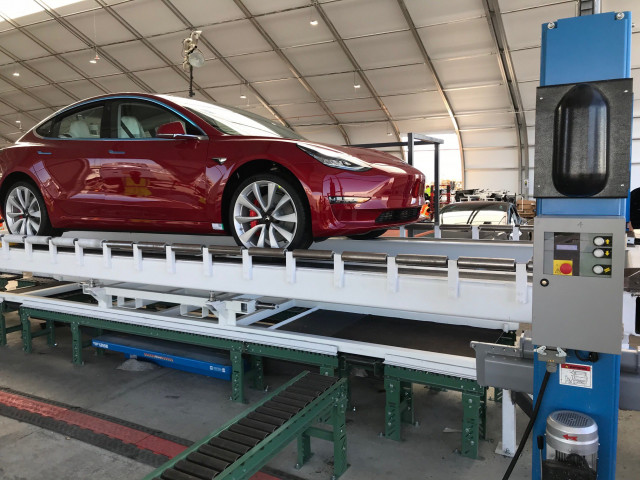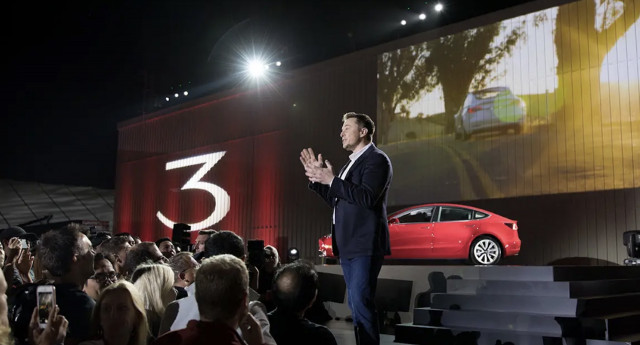
Tesla Model 3 all-wheel drive Performance rolls off a new assembly line in a temporary structure
Tesla finally introduced its long-promised $35,000 Model 3 earlier this month, but it still isn't delivering them according to numerous media and owner reports.
In the call introducing the Standard Range Model 3, Tesla CEO Elon Musk said the first cars would be delivered in two to four weeks, but buyers who have ordered Standard Range Model 3 sedans have reported on at least three different Tesla forums that they have received texts from Tesla saying their deliveries have been delayed, and been given no updated delivery date.
When we contacted the company to ask about the delivery schedules, Tesla declined to comment.
DON'T MISS: Tesla Model 3 Standard Range arrives soon at $35,000 and 220 miles. Really.
As it introduced the base Standard Range Model 3, Tesla also announced an unexpected new model, the Standard Range Plus, with 20 miles of additional range and what Tesla calls a Partial Premium Interior. The Model 3 Standard Range Plus sells for $39,310 to start. (The equivalent price for a non-Plus Standard Range model, with delivery, is $36,200.)
Plenty of buyers say they have confirmed delivery dates for Standard Range Plus models (though some have been delayed), but in an extensive search, we could find no references to base Standard Range models that still have confirmed delivery dates, which has led some to question whether Tesla has really started building base cars.
Some Standard Range Model 3 buyers say Tesla representatives have called them and tried to upsell them into more profitable models.
MUST READ: Commentary: Tesla races to outrun perfect storm from tax credit, production, cost hurdles
Last summer, CEO Elon Musk said on Twitter that it could not afford to build the base model until several months of "full production" of better-equipped, more expensive models, or "Tesla will die."
In the base Model 3 announcement, Musk said that the company would close all its stores to cut enough costs to generate a return on the base Model 3 at $35,000. Since then it has reversed that decision and reopened most stores. It has also raised prices on all of its other models to offset the losses from leaving stores open and building the $35,000 Model 3. In a blog post explaining the measure, the company said, "We will only close about half as many stores, but the cost savings are therefore only about half.”
Yet there's still no evidence that the company is actually building the car.
DON'T MISS: Tesla will raise prices on all but $35k Model 3, keep more stores open
During the introductory call, when Green Car Reports asked when new buyers might get the car, Musk said: "It is very likely that someone who orders will get the car in the US by the end of June, let's say. Before the next tax-credit cliff."
That timeline is critical, because Tesla's cars are already eligible for only half the plug-in vehicle tax credit that those from most other automakers are, and several others now sell for the about the same nominal $35,000 sticker price. On June 1, Tesla's tax credit will fall by another $1,875.
The tax credit could be particularly important for price-sensitive buyers looking for a rock-bottom price on a new Model 3.

Elon Musk at Tesla Model 3 reveal
There could be an additional reason that the Standard Range Model 3 is delayed even while the Standard Range Plus is not: While the Standard Range Plus is essentially a decontented version of the Mid Range Model 3 that Tesla sold from November through February, the entry-level Standard Range car has more manufacturing differences from other models, including fully manual seats with cloth upholstery not offered in any other Model 3, and a different center console. Those are parts that may take longer for the company to ramp up from suppliers. And it may be that in addition to generating less revenue, the base Model 3 may add to manufacturing cost and complication.
READ MORE: Tesla shuts down Model 3 production for five days amid quality concerns
Tesla's original accounting for Model 3 costs, prices, and profits was undoubtedly built on Musk's assumption that his fully automated "alien dreadnaught" assembly line would dramatically cut production costs—a prediction that famously didn't pan out last spring as the company struggled to ramp up production of the Model 3, ripped out parts of the automated assembly line, and hired workers to replace them—then built a separate, less automated line in a tent outside the main factory.
The costs of those extra workers could still be pinching the Model 3's bottom line, even after Tesla laid off more than 9 percent of its managerial and engineering workforce to save money.
In the meantime, based on forum responses (and following the comments of our readers), it looks like releasing the Standard Range Plus along with the Standard Range may have been a good move on Tesla's part: The vast majority of commenters who have placed new orders seem to have placed them for the Standard Range Plus, generating a little bit of extra cash for Tesla—and ensuring that their new cars arrive within weeks, rather than months.